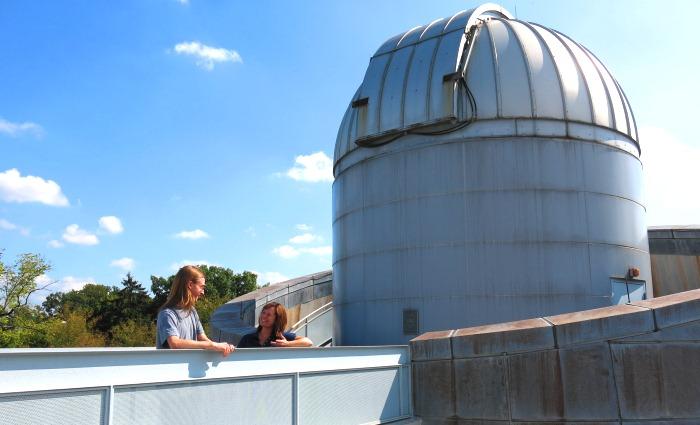The Stars Look Very Different Today

Ben Kimock ’15 and Associate Professor of Physics & Astronomy Catrina Hamilton-Drager take a break from their research outside the Britton Observatory. (Photo by Tony Moore)
by Tony Moore
The week of Sept. 12, you may have come across a headline reading something like this: "Voyager 1 Becomes First Human-Made Object to Leave Solar System" (CNN.com). NASA's Web site tells us that Voyager 1 "has traveled farther than anyone, or anything, in history," which right now places it more than 11.7 billion miles from Earth.
But launched in 1977, Voyager 1 doesn't know that it has left the solar system, so it can't relay back that it has, and its plasma-detection instrument—which would be a key indicator of where the spacecraft might be—broke in 1980, so there is some controversy as to exactly how far into space it is. Untangling the meaning of and debate behind this historic event is Catrina Hamilton-Drager, associate professor of physics & astronomy, who quickly places Voyager 1 into context below.
*****
This event (regardless of the controversy surrounding it) is an amazing feat for humankind. When you think about the size of our galaxy, let alone the universe, and how tiny we are, it's impressive that we have been able to create something using the laws of physics that has remained active for more than 30 years, has successfully visited some of the outer planets and their moons and is now entering the "interstellar" space.
What exactly it will tell us now, and the importance of that story, is yet to be determined. Voyager 1 will function until about 2025, so we still have some time to investigate our theories of exactly what interstellar space is composed. I think this is the most important impact Voyager 1 will have on humanity. Space is so vast, it will not encounter another star for approximately 40,000 years or so, and by then, who knows if we'll even be here.
Controversy lies in the fact that it is unclear whether Voyager 1 has officially left the heliosphere. The general idea is that yes, it has left, based on the flow of particles from the sun versus the flow of particles in from interstellar space.
Voyager 1 is at a distance of 18.8 billion km from the sun. That puts it at a distance of about 120 AU (astronomical units—the unit most commonly used for distances within the solar system, which is equal to the distance between the Earth and the sun). If we only consider the eight planets plus the handful of known dwarf planets (some of which reside within the Kuiper Belt), the size of our solar system has a radius of about 50 AU. By that standard, we certainly have left the solar system.
On the other hand, there is a cloud of icy objects that encircles the sun, known as the Oort cloud, which has a radius of roughly 30,000 to 50,000 AU. From that perspective, Voyager 1 has not left the solar system. But even the existence of the Oort cloud is debated.
At any rate, Voyager 1 certainly has given us a chance to probe far beyond the reaches of any regular laboratory experiment. Who knows what we'll learn next?
Read more:
Dickinson's Department of Physics & Astronomy
Published September 22, 2013